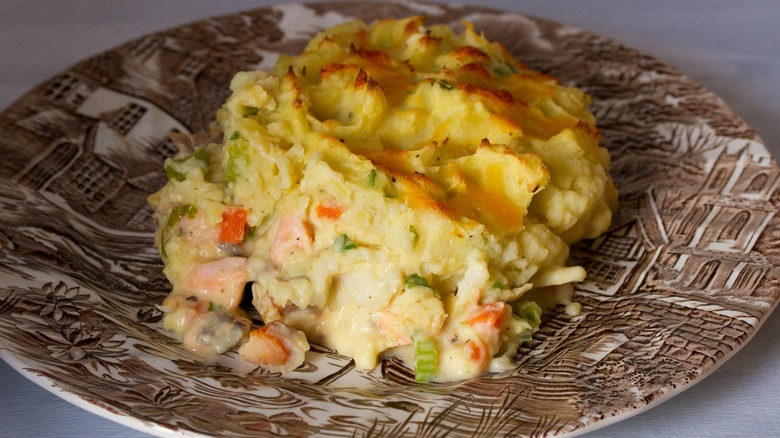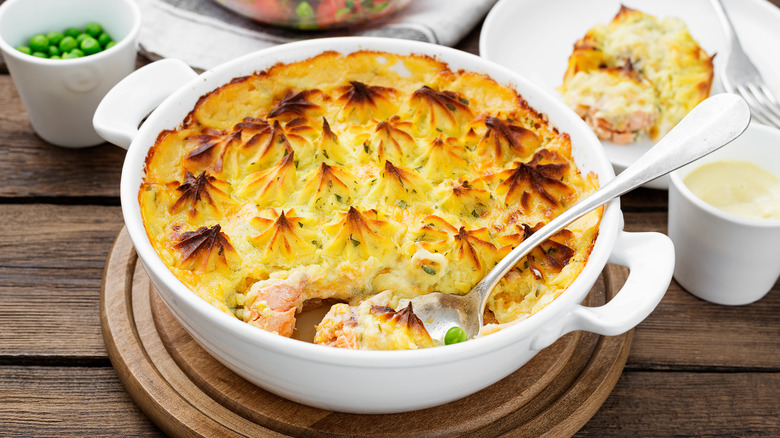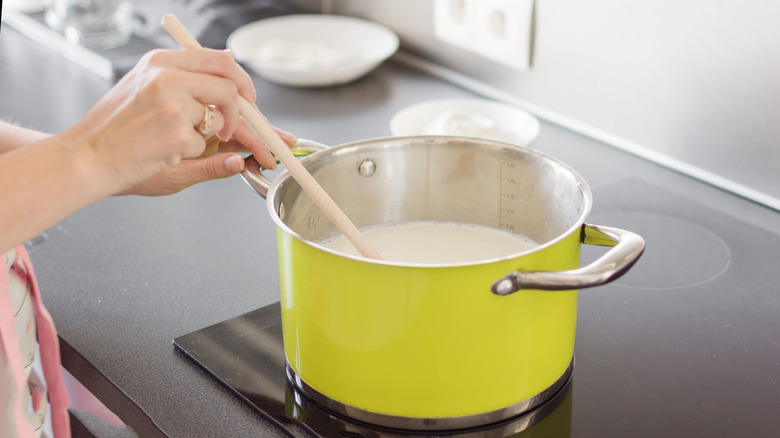What Is Fisherman's Pie And What Type Of Fish Does It Use?
While there are many comfort foods that hail from Britain, we're thankful that the classic shepherd's pie became so popular around the world. Although this savory casserole dish is a traditional staple in homes and pub menus across the pond, it has a seafood-infused cousin that is just as common.
Fisherman's pie, simply called fish pie, is topped with a pillowy layer of mashed potatoes just as shepherd's pie is. Rather than containing lamb or ground beef, however, the star of this pie is fleshy white fish that breaks apart tenderly when cut into. The pies often contain a mix of different kinds of seafood, adding to the its tasty complexity. It's generally considered an affordable and easy meal to prepare since white fish tends to be less expensive by the pound than other types of fish.
As the recipe for fisherman's pie has been passed down over generations, it's taken on many unique forms. Some families will stick with tradition while others might choose to bake an extra dash of culinary creativity into their version by using different aromatics, wines, or veggies. One key ingredient that unites most existing variations of fisherman's pie is the filling's creamy white sauce that the fish is cooked in. Without it, the dish may lack the rich-tasting seafood essence it's known for. There are some recipes that swap the white sauce out for a roux with a different, buttery base.
Today's version probably stems from medieval times
Fish pie's direct origin is murky and full of theories, but there are many accounts of seafood pies that were baked for royalty dating as far back as the reign of Henry I. His love of lamprey pie lives on as an English coronation custom to this day and is a tradition that King Charles III politely declined. Today's version of fisherman's pie is thought to have stemmed from the Christian observance of Lent during the Middle Ages, a fasting period when meat was banned. Pies were instead filled with random bits of whatever fish was locally available as the alternative. Food historians have determined that cream wasn't specifically introduced into the recipe, along with instructions, until a couple thousand years later in published cookbooks.
Even with all those possibilities to explore, the traditional British fish pie is commonly believed to have first emerged in Scotland. Besides being a go-to supper idea throughout the UK, it's also a staple dish in Ireland, transformed into a spice-infused meal in India, and frequently eaten in Alaska where fish is the primary local food source. While fish pie is mostly baked using cod, there are many variations that include other kinds of white fish such as haddock, halibut, or pollock. Home chefs will sometimes combine it with another type of smoked fish like salmon as well as scallops or prawns so that even more flavors can be showcased in their pie.
How to make traditional British fish pie
Ideally, when you're procuring your seafood to make this quintessentially British meal, you'll want it to be fresh. However, you can opt for frozen fish as long as you fully defrost it to avoid a disappointingly soggy pie. For those who want to use more than one fish, adding a smoked variety along with a fleshy kind like cod will give you extra flavorful results. That's especially true if you throw prawns or scallops into the mix. Before doing anything with the fish, though, it's important to prepare your homemade mashed potatoes beforehand.
Here's where the key ingredient comes into play for melding all those savory fish pie flavors together. The secret is to poach them in a milk-based béchamel sauce for a few minutes with bay leaves. Fisherman's pie only has a few veggies, which are mainly leeks or onions simmered in butter and dry wine, but some recipes call for peas, mushrooms, or even baby spinach. It's up to you what you want your taste buds to experience in your pie's filling. A few shakes of parsley and thyme later and the fluffy lid of mashed potatoes can be spooned on right before sliding it into the oven. A golden brown surface and thickened, bubbling insides tell you it's done and ready to devour. The best part is that the more you recreate this meal, the more you can tweak it to get your seafood and sauce combo just right.


